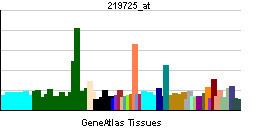Species Human Entrez 54209 | Human Mouse Ensembl ENSG00000095970 | |
 | ||
Aliases TREM2, TREM-2, Trem2a, Trem2b, Trem2c, triggering receptor expressed on myeloid cells 2 External IDs MGI: 1913150 HomoloGene: 10352 GeneCards: TREM2 | ||
Triggering receptor expressed on myeloid cells 2 also known as TREM-2 is a protein that in humans is encoded by the TREM2 gene.
Contents
Function
Monocyte/macrophage- and neutrophil-mediated inflammatory responses can be stimulated through a variety of receptors, including G protein-linked 7-transmembrane receptors (e.g., FPR1), Fc receptors, CD14 and Toll-like receptors (e.g., TLR4), and cytokine receptors (e.g., IFNGR1). Engagement of these receptors can also prime myeloid cells to respond to other stimuli. Myeloid cells express receptors belonging to the Immunoglobulin (Ig) superfamily, such as TREM2, or to the C-type lectin superfamily. Depending on their transmembrane and cytoplasmic sequence structure, these receptors have either activating (e.g., KIR2DS1) or inhibitory functions (e.g., KIR2DL1).
Clinical significance
Homozygous mutations in TREM2 are known to cause rare, autosomal recessive forms of dementia with an early onset and presenting with or without bone cysts and fractures.
A rare missense mutation (rs75932628-T) in the gene encoding TREM2, (predicted to result in an R47H substitution), confers a significant risk of Alzheimer's disease. Given the reported antiinflammatory role of TREM2 in the brain, it is suspected of interfering with the brain’s ability to prevent the buildup of plaque. TREM2 mutations increase the risk of neurodegenerative conditions such as Alzheimer's disease, amyotrophic lateral sclerosis, and Parkinson's disease. TREM2 interacts with DAP12 in microglia to trigger phagocytosis of amyloid beta peptide and apoptotic neurons without inflammation. Mutations in TREM2 impair the normal proteolytic maturation of the protein which in turn interferes with phagocytosis and may therefore contribute to the pathogenesis of Alzheimer's disease.
Soluble TREM2 has been detected in human cerebrospinal fluid (CSF), where it was found to be elevated in CSF of patients with multiple sclerosis and other inflammatory neurological conditions in comparison to patients without inflammatory neurologic disorders.
